Science and extension
Pre-1940 Activity
Despite numerous “Experimental Farms” being established from Millicent to Manna Hill little mention can be found of government funded cattle research or extension until the 1940s. Kybybolite Experimental Farm was established in 1905 but focused on cereals, fodder, green pasture, sheep, pigs and an orchard. (Geytenbeek P, Kybybolite Experimental Farm - a History, (2003)). Even early pasture work was focused on improving the soil for cereal crops. In Jeff Daniel’s book on the first century of Roseworthy College, in the chapter on animal production, no reference is made to beef cattle research until the 1980s. (Daniels Jeff, Editor, Roseworthy Agricultural College, A Century of Service, Roseworthy Agricultural College, SA (1983)).
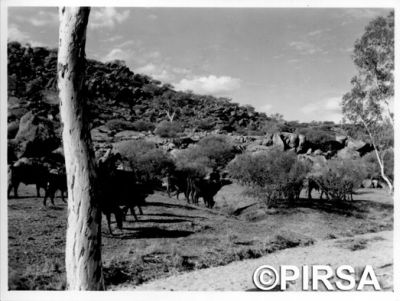
Photo No.: 103757 Title: Northern store cattle grazing bush. Date: May 1959
For example, a sample exam paper had no beef cattle questions, and it was not until 1942 that beef cattle were introduced to Roseworthy with a small number of northern Shorthorn cows and a Red Poll bull. In 1943–4 a stud bull and nine cows were purchased from the Nalpa stud as the basis for the College’s successful Shorthorn Stud. Following an outbreak of vibriosis in 1980 a reduction in numbers resulted in the herd becoming an objectively measured commercial herd.
In recent years the University of Adelaide has refocused its animal production program and centralised it at the Roseworthy campus.
Post-1940 Activity
From the 1940s the government started taking a more active interest in beef cattle. As discussed in the pasture section, the State and Commonwealth governments’ War Service Land Settlement program reduced the scale of many extensive beef properties but also the research into trace elements and the development of subterranean clover enabled vast areas of previously infertile mallee scrub, heath and lateritic soil country to be brought into production in the South East, Kangaroo Island and southern Eyre Peninsula. This resulted in primarily pasture properties breeding prime lambs, producing wool and in increasing numbers running herds of beef cattle in conjunction with their sheep.
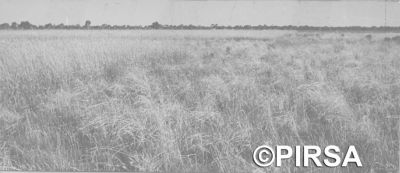
Photo No.: 106573 Title: Development of legume pastures on cleared land (photo from D. S. Riceman, CSIRO). Date: c.1950
Research
Work at Kybybolite demonstrated the substantial improvement in pasture production achieved with subterranean clover, various grasses and superphosphate. (Geytenbeek P, Kybybolite Experimental Farm - a History, (2003)) However it was not until the early 1950s that beef cattle were introduced after the dairy cattle were sold. In 1951, under the auspice of Dr Allan Callaghan as Director of Agriculture, land was obtained at Struan, south of Naracoorte as an outstation. Kybybolite Research Centre
Initial work into the supplementary feeding of beef cattle commenced at Kybybolite with results suggesting that high protein grain such as peas produced satisfactory gains but that self-fed ensilage was little better than dry pasture residues. (McAuliffe JD, Kybybolite Link). Hereford cattle were bred to calve at the Centre in 1956 and 1957. A study looked at the effect of age at first mating on growth and production of heifers. In the first year a high percentage of heifers calving at 2 years had difficult births and required assistance. However, in the following season this problem did not occur. It was concluded that heifers could be safely mated during their second year providing care was taken to avoid having them over-fat at calving. This was a significant increase in production efficiency. The use of an Aberdeen Angus bull to produce a ‘smaller’ calf was shown not to be effective. While the cattle performed well in the dry season of 1957 they did not fare well in the very wet season of 1958 and all were transferred to Struan the following year.
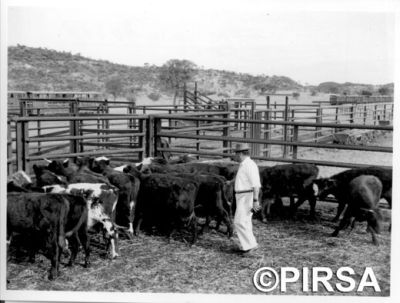
Photo No.: 103751 Title: Ron McNeil with Northern store heifers for transportation from Alice Springs to Struan and Turretfield Research Centre. Date: May 1959
An early reference to cattle research or extension in the Department of Agriculture can be found in 1955 leaflet “Bruising of Cattle in transit from Central Australia to Adelaide”. (SA Beef Cattle Breeders Association). Some of the early work at Struan focused on the fattening of northern store cattle. The subsequent recommendation was to breed cattle in the northern pastoral areas and then rail young cattle to the “inside country”, particularly the improved pasture country of the South East for fattening.
The 1960s saw Struan developed as a research facility with offices, fences, laneways, yards and pasture improvement. Subsequently, research and support staff followed. By 1970 the property covered 2000 acres (800 ha) and carried over 1000 beef cattle. Research focused on breeding, management, finishing and carcase evaluation. The establishment of a “meat laboratory” allowed scientific dissection of muscle and carcases to determine meat yields of various breed types. Extensive extension was also carried out in the media and research on private properties. A performance recorded hereford herd at Struan provided the basis for evaluating selection methods on cooperating commercial herds. They were provided with high or average growth rate bulls and then staff from the Centre would weigh and record the outcome.
In 1969 frozen semen was allowed into Australia from England, and Struan was at the forefront of both using artificial insemination in beef cattle and the evaluation of a range of breeds including shorthorn, hereford, brahman and the imported charolais breeds. Additional work included examining the impact and genetics of muscular hypertrophy, calving difficulty in two year old heifers and multiple suckling of calves on dairy cows. One of the significant changes that occurred at this time and improved beef cattle production efficiency was the mating of heifers to calve as two year olds rather than three year olds.
During the 1970s beef herds were introduced to a number of existing agricultural research centres including Minnipa, Parndana, Turretfield and Wanbi to both demonstrate modern production methods and carryout cross breeding research.
Extension
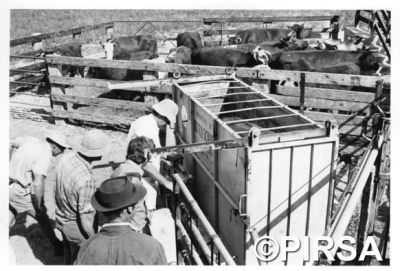
Photo No.: 103730 Title: M. Milne demonstrating weighing cattle. Date: 16 Mar 1973
The expanding export markets saw the number of properties with beef cattle increase rapidly and demand for information on beef cattle management escalate. The Department of Agriculture ran “Beef Cattle Husbandry Schools” across the State and numerous extension activities including field days, publications, radio, local television and in the press. Integral to adopting objective measurement of beef cattle was the use of cattle scales, ranging from originally measuring tapes to spring, hydraulic and today electronic scales. Stock agents and stud breeders assisted many of these growers moving to beef production for the first time. With funding from the JS Davies Fund University researchers were employed and a series of seminars were run to expose beef producers to latest techniques and information both local and international.
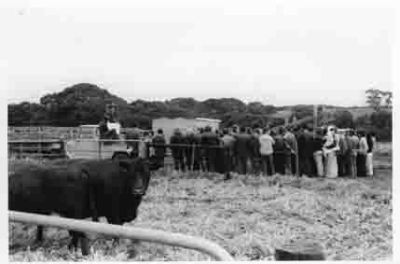
Photo No.: 103920 Title: Crowd gathered at cattle trials at Field Day, at Kangaroo Island Research Centre. Date: 26 Sep 1974
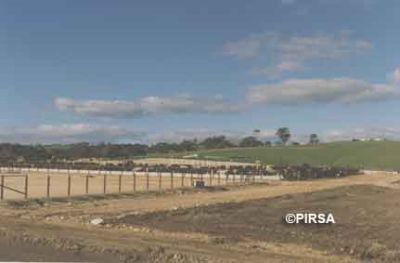
Photo No.: 106351 Title: Cattle feed lot at Blyth. Date: Aug 1994
Today technical innovation continues with the ability to trace beef from production to consumption providing both quality and health status feedback to customers in Australia or across the world.
Meat Science Research
The use of objective measurement of carcases, AUS-MEAT description system and the development of liveweight selling led to the introduction of objective breeding of cattle and subsequently Breedplan. This is widely adopted in the stud industry today and used in conjunction with traditional selection methods to identify superior genes.
Carcase Competitions
1953 saw the introduction of carcase competitions to allow producers to see the end point of the work that had gone into breeding and fattening their beef carcases.
Early beef competitions emphasised the importance of the northern cattle industry with the largest section being the 'Pens of Three' heavy bullocks entered by northern pastoralists.
These competitions developed into a major annual event for the State’s beef industry, providing an opportunity for producers and buyers to mix together and observe the carcases of the animals they had produced. As cattle numbers in the south increased the categories and types of domestic classes increased. The competitions were judged by objective scoring systems developed nationally with significant involvement by South Australian industry and government personnel. Some country show committees ran local competitions and the RAHS still runs an annual pure breed competition in conjunction with the Royal Show.
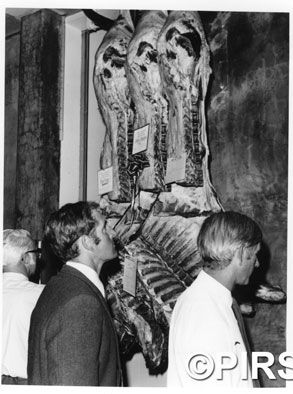
Beef Carcase appraisal Gepps Cross 1973

Carcase appraisal of beef at Gepps Cross abattoir 1973
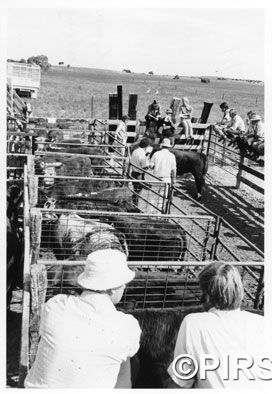
Photo No.: 103727 Title: Judging live cattle in a steer competition. Date: 16 Mar 1973
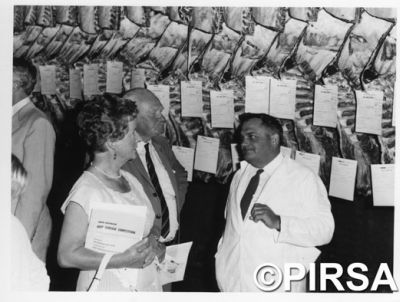
Photo No.: 103681 Title: Ron McNeil, judge, explaining the results of the beef carcass appraisal. Date: Jan 1973
The Stud Beef Breeders Association runs a number of breed promotion and extension activities in addition to their role at the Royal Show. The annual SA Beef Cattle Field Days give stud breeders a unique opportunity to display their cattle at home on the property, and the aim of the popular SA Junior Heifer Expo “is to continue to improve the Expo as a platform for our youth within the beef industry, allowing further development of their knowledge, experience and opportunities in life and enabling them to become tomorrow's leaders” .
